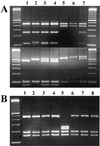Molecular characterization of cryptosporidium oocysts in samples of raw surface water and wastewater
- PMID: 11229897
- PMCID: PMC92700
- DOI: 10.1128/AEM.67.3.1097-1101.2001
Molecular characterization of cryptosporidium oocysts in samples of raw surface water and wastewater
Abstract
Recent molecular characterizations of Cryptosporidium parasites make it possible to differentiate the human-pathogenic Cryptosporidium parasites from those that do not infect humans and to track the source of Cryptosporidium oocyst contamination in the environment. In this study, we used a small-subunit rRNA-based PCR-restriction fragment length polymorphism (RFLP) technique to detect and characterize Cryptosporidium oocysts in 55 samples of raw surface water collected from several areas in the United States and 49 samples of raw wastewater collected from Milwaukee, Wis. Cryptosporidium parasites were detected in 25 surface water samples and 12 raw wastewater samples. C. parvum human and bovine genotypes were the dominant Cryptosporidium parasites in the surface water samples from sites where there was potential contamination by humans and cattle, whereas C. andersoni was the most common parasite in wastewater. There may be geographic differences in the distribution of Cryptosporidium genotypes in surface water. The PCR-RFLP technique can be a useful alternative method for detection and differentiation of Cryptosporidium parasites in water.
Figures

Similar articles
-
Detection and differentiation of Cryptosporidium oocysts in water by PCR-RFLP.Methods Mol Biol. 2004;268:163-76. doi: 10.1385/1-59259-766-1:163. Methods Mol Biol. 2004. PMID: 15156028
-
Distribution of cryptosporidium genotypes in storm event water samples from three watersheds in New York.Appl Environ Microbiol. 2005 Aug;71(8):4446-54. doi: 10.1128/AEM.71.8.4446-4454.2005. Appl Environ Microbiol. 2005. PMID: 16085835 Free PMC article.
-
[Investigation of the presence of Cryptosporidium spp. in different water sources in Mersin province, Turkey].Mikrobiyol Bul. 2012 Jan;46(1):93-100. Mikrobiyol Bul. 2012. PMID: 22399176 Turkish.
-
[Comparative study of PCR-based Cryptosporidium discriminating techniques with a review of the literature].Kansenshogaku Zasshi. 2002 Oct;76(10):869-81. doi: 10.11150/kansenshogakuzasshi1970.76.869. Kansenshogaku Zasshi. 2002. PMID: 12448847 Review. Japanese.
-
[New methods for the diagnosis of Cryptosporidium and Giardia].Parassitologia. 2004 Jun;46(1-2):151-5. Parassitologia. 2004. PMID: 15305706 Review. Italian.
Cited by
-
Performance of diagnostic assays used to detect Cryptosporidium oocysts in faecal samples of cattle in Kuwait and genotyping of Cryptosporidium species.BMC Vet Res. 2022 Sep 7;18(1):336. doi: 10.1186/s12917-022-03435-w. BMC Vet Res. 2022. PMID: 36071437 Free PMC article.
-
Investigations and comparative detection of Cryptosporidium species by microscopy, nested PCR and LAMP in water supplies of Ordu, Middle Black Sea, Turkey.Ann Trop Med Parasitol. 2011 Dec;105(8):607-15. doi: 10.1179/2047773211Y.0000000011. Ann Trop Med Parasitol. 2011. PMID: 22325820 Free PMC article.
-
Occurrence and potential health risk of Cryptosporidium and Giardia in different water catchments in Belgium.Environ Monit Assess. 2015 Feb;187(2):6. doi: 10.1007/s10661-014-4157-z. Epub 2015 Jan 24. Environ Monit Assess. 2015. PMID: 25616782
-
The first reported cases of human cryptosporidiosis caused by Cryptosporidium hominis in Slovak Republic.Folia Microbiol (Praha). 2013 Jan;58(1):69-73. doi: 10.1007/s12223-012-0182-x. Epub 2012 Jul 24. Folia Microbiol (Praha). 2013. PMID: 22826020
-
Molecular fingerprinting of Cryptosporidium oocysts isolated during water monitoring.Appl Environ Microbiol. 2006 Aug;72(8):5428-35. doi: 10.1128/AEM.02906-05. Appl Environ Microbiol. 2006. PMID: 16885295 Free PMC article.
References
-
- Chung E, Aldom J E, Carreno R A, Chagla A H, Kostrzynska M, Lee H, Palmateer G, Trevors J T, Unger S, Xu R, De Grandis S A. PCR-based quantitation of Cryptosporidium parvum in municipal water samples. J Microbiol Methods. 1999;38:119–130. - PubMed
-
- Chung E, Aldom J E, Chagla A H, Kostrzynska M, Lee H, Palmateer G, Trevors J T, Unger S, Degrandis S. Detection of Cryptosporidium parvum oocysts in municipal water samples by the polymerase chain reaction. J Microbiol Methods. 1998;33:171–180.
-
- Di Giovanni G D, Hashemi F H, Shaw N J, Abrams F A, LeChevallier M W, Abbaszadegan M. Detection of infectious Cryptosporidium parvum oocysts in surface and filter backwash water samples by immunomagnetic separation and integrated cell culture-PCR. Appl Environ Microbiol. 1999;65:3427–3432. - PMC - PubMed
Publication types
MeSH terms
Substances
LinkOut - more resources
Full Text Sources
Medical

